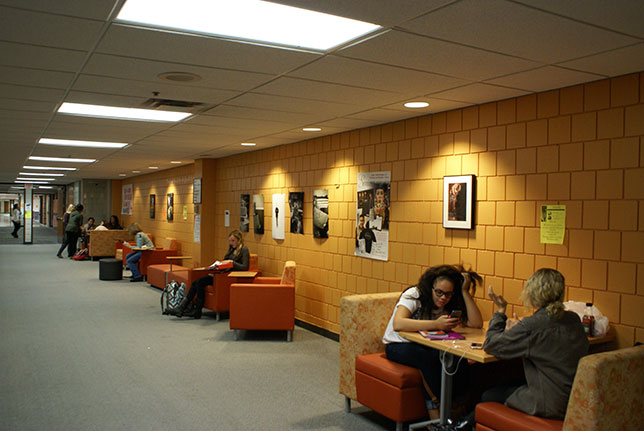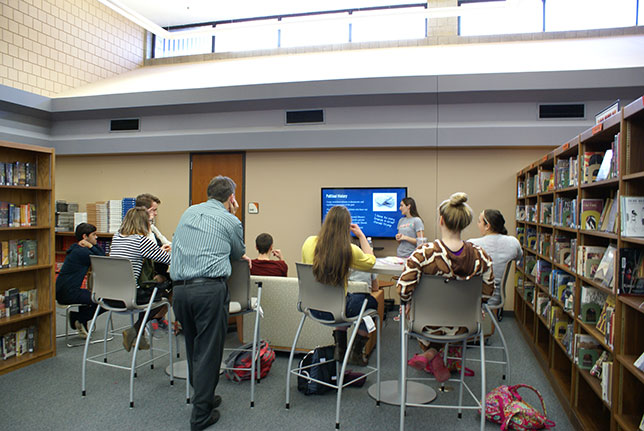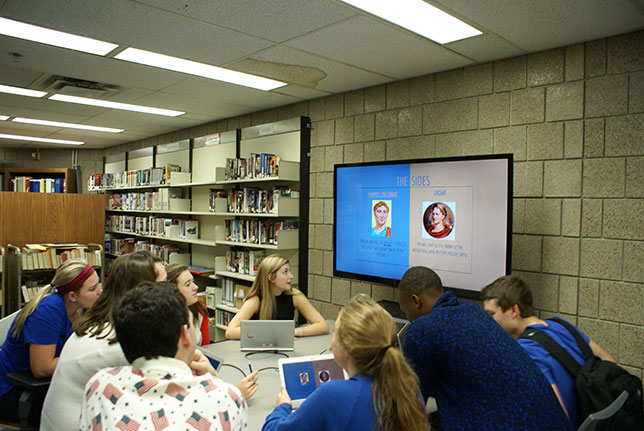Learning & the Library
How the School Library Helps Build Strong Blended Classes
White Bear Lake Area High School - South Campus is in its third of year of offering a variety of hybrid or blended classes from economics to health/physical education. This suburban St. Paul school of 11th and 12th graders is committed to providing blended in-class and independent study. With more than 265 students in nine hybrid classes coming to the school library and learning commons, there is a wealth of opportunities to work together. As Michael Wesch states, "to connect, organize, share and collaborate,… we have to move from knowledgeable — that is just knowing a bunch of stuff — to being actually knowledge-able; that's being able to find sort, analyze, criticize, and ultimately create new information and knowledge."
This is the first in a series of articles describing 10 ways White Bear Lake High School teachers and the school library are working together to enhance learning in hybrid or blended classes. There are many roles being played by teacher librarians in working with traditional and hybrid classes including: blended librarian, instructional designer, resource linker and teacher/subject matter expert. We are striving to incorporate all these in building strong hybrid classes. In future installments we'll cover hybrid orientation, deep Web online lessons, Web 2.0 applications and ELL hybrid classes.
Learning Commons: Collaboration Stations
For both hybrid and traditional classes our goal is to go beyond offering great reads and distributing textbooks to building and maintaining strong helping relationships with our students and staff. With so many hybrid students spending their out-of-class time in the media center, it made sense to rethink the design and layout of the library. We wanted to, as Scott Bennett puts it, "foster a culture of intentional learning."

Bear Commons
One of our first projects was to begin the process of transforming the library into a learning commons. Since our book club visited the University of Minnesota Rochester Library and Information Commons, we had a pretty good idea of how we wanted the library to look. The U of M Rochester has at least a half a dozen areas with comfy chairs and high tables that gave it the feel of a bistro/info center.
My principal, Tim Wald, and I also toured the high school media center in Chaska, MN to get a better idea of how flexible seating is being used there. Then we met with representatives from several commercial furniture companies. This resulted in a plan to add a commons area to the entrance to the library, which we affectionately called the "front porch." With ample space in the corridor at the front to the library, it was possible to incorporate booths, comfy chairs and ottomans that students can arrange to work in groups.
In addition, we discarded more than a thousand old professional development and nonfiction books. This made it possible to tweak the layout of the book shelves to accommodate more commons areas in the library. We added several high tables and chairs in the library with more comfy chairs with writing tablets. We also purchased about a dozen essay chairs. These are student desks that have swivel seats, caster wheels and writing tablets. They are very flexible and great for individual and small group work. In an instant, students can create a space to collaborate. Also added were several more quiet areas to give students a place to work independently without interruptions.

We added several high tables and chairs in the library with more comfy chairs with writing tablets.
With the front porch completed, we had a "Name that Space" contest, where students could go to our library Web site and enter their suggestions. The winning name for the area was The Bear Commons.
We have also made space for teacher work areas in the library. There are five workstations for teachers to work outside the classroom, meet with their hybrid students and also work with colleagues to plan and develop lessons.
Collaboration Stations:
Collaboration Stations are designed to make it easier for students to present and work with each other in small and larger groups, "transforming passive meeting areas into dynamic team spaces." Betsy Habich, administrative operations manager at Northeastern University Libraries, says, "We are excited the library is able to offer this innovative way to support student collaboration. In a shared digital information environment growing richer by the day, libraries need to include facilities that support research and creativity in new and exciting ways."

The collaboration stations are ideal for group work because everyone can plug in their Chromebooks or laptops and take turns displaying their screens on the monitor.
We believe this applies to our high school library as well. The Collaboration Stations in our library enable students to display the screens on their Chromebooks and other devices to a large monitor. The stations are ideal for group work because everyone can plug in their Chromebooks or laptops and take turns displaying their screens on the monitor. We use Chromecast, VGA or HDMI connectors to connect to the monitors. The collaboration station housed in our media office will accommodate up to six users with additional seating for up to eight essay chairs so that as many as 12 students can meet at one time.
Our first project was with our hybrid American Government class where students completed the "I Side With.com" survey. Using the "I Side With" site, students can take a simple survey covering eight categories and be presented with a list showing how their specific interests and beliefs match up with each candidate. Each student completed the online questionnaire independently. Once the students had finished, they recorded their results in their journals and prepared for online discussions.
Two American Democracy classes used the large collaboration station to share Google presentations. After each groups had finished, they reviewed their summaries with the entire class. Hybrid students have also accessed their shared Google documents to have a complete record of their meetings.
The new collaboration stations and the learning commons were acquired with our district, building, and library sharing the cost. We are continuing to work with staff and students to make decisions about types of space and furniture needed for quiet work and group activities for traditional and hybrid classes. We plan to expand the collaboration stations as students become more familiar with the technology.
About the Author
David Olson is a media specialist at White Bear Lake Area High School - South Campus in White Bear Lake, MN.